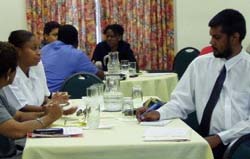
Photo: USAID/Carter Center Melanie Reimer
Guyanese lawyers being trained in mediation techniques,
prior to the opening of the Mediation Center.
“I did not know the matter could be settled so easily, I could have saved time and money.”
- Guyanese litigant
|
Initiative
In 2003, USAID undertook an Alternative Dispute Resolution (ADR) program to address the backlog of cases in Guyana. A pilot project provided training to twenty-four Guyanese lawyers and established an mediation center.
Initially, seven types of civil cases were identified as being eligible for the pilot project – criminal and family cases were excluded. In addition, a new course on ADR was introduced in the curriculum of the University of Guyana Law Department. Two Guyanese non-governmental organizations – the Guyana Bar Association, and Guyana Association of Women Lawyers – proved to be strong advocates for ADR, providing an invaluable foundation of leadership and support for USAID’s initiative.
|
|
Results
By March 2004, ninety-eight cases had been referred to the new system. Some cases were challenging – one involved a bitter split between factions of a church (the first case settled under the pilot project) and another involved a land dispute among family members. As the mediation project becomes more integrated into the justice system, more judges refer cases to mediation. The Chief Justice and Chancellor placed considerable influence behind further development of ADR in Guyana and attorneys are volunteering cases for mediation.
In Guyana’s 2003 Annual Court Registry Report, the registrar gave a ringing endorsement of ADR, and the Attorney General also voiced his support for the project. These are all clear indications that court-assisted mediation, a technique in which justice personnel had no prior experience, is now not only being enthusiastically supported by Guyana’s justice
sector, but increasingly accepted by its citizens as a means to resolve disputes in a timely manner.
Print-friendly version of this page (257kb - PDF)
|
|


